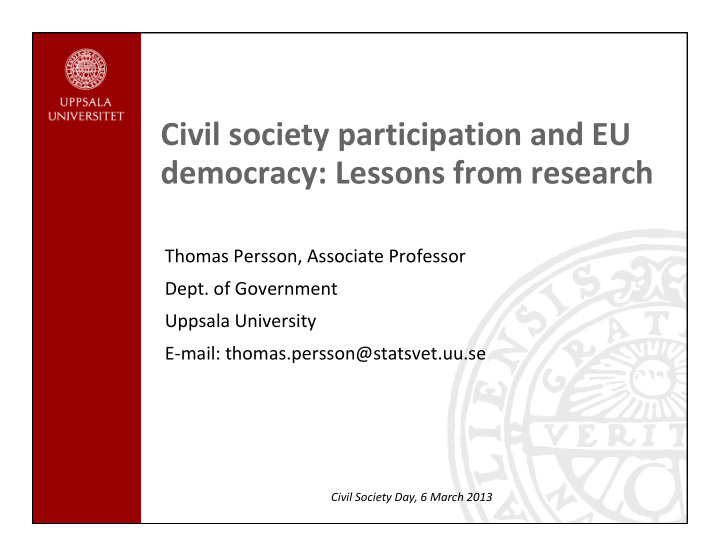



Civil society participation and EU democracy: Lessons from research Thomas Persson, Associate Professor Dept. of Government Uppsala University E-mail: thomas.persson@statsvet.uu.se Civil Society Day, 6 March 2013
The EU’s democratic deficit • Less than half of European citizens are satisfied with democracy in the EU. Source: Eurobarometer Figure 1. Satisfied with democracy in the EU (average) Civil Society Day 2013
Political representation in the EU • Three forms of representation in the Union Figure 2. Three strategies for strengthening democracy in the EU Civil Society Day 2013
Participatory governance • White Paper on European Governance – “…open up the policy-making process [in order] to get more people and organisations involved in shaping and delivering EU policy” (COM 2001) • More involvement of civil society – the way forward? – …an effective means for enhancing the democratic quality of EU policies and increasing the problem-solving capacity of the Union. – …serve sooner to deepen than to alleviate the Union’s problems with democracy and efficiency. Civil Society Day 2013
REACH – an early test • The new regulatory system for chemicals, REACH, an early test of the participatory- governance strategy – “…[b]lue print for participatory law-making more generally” (Heyvaert 2008:198) – “…it reinstalled key players in a veto position and did little to enhance effective participation of the public” (Pesendorfer 2006:111) • Data from an expert survey with more than 600 respondents from over 40 countries Civil Society Day 2013
Six conditions for democratic EU policy-making 1. The organisations involved in EU policy-making accurately represent the views of their members. 2. Political cleavages in the Union are functional rather than territorial. 3. All interests enjoy equal and adequate representation in EU policy-making fora. 4. All interests have equal and adequate access to relevant information. 5. All interests have an equal and adequate influence on policy. 6. Broad access to information and policy-making fora does not interfere with decision-making efficiency.
Functional or territorial political cleavages? AU GE IR TC IT UK BE NE FR SP CC LU FI PO SW GR DE .2 .4 .6 .8 1 Support for regulations Notes: AU=Austria, GE=Germany, IR=Ireland, TC=Third country, IT=Italy, UK=United Kingdom, BE=Belgium, NE=Netherlands, FR=France, SP=Spain, CC=Candidate Country, LU=Luxembourg, FI=Finland, PO=Portugal, SW=Sweden, GR=Greece, DE=Denmark. Figure 3. Confidence-interval plot for position on REACH by country Civil Society Day 2013
Functional or territorial political cleavages? IA TCG PB IO EP MSG EC UN OEU APC CO NGO AC .2 .4 .6 .8 1 Support for regulations Notes: IA=Industry Association, TCG=Third-Country Government, PB=Private Business, IO=International Organisation, EP=European Parliament, MSG=Member state governments, EC=European Commission, UN=Trade Union, OEU=Other EU Institutions, APC=Applicant-Country Government, CO=European Council, NGO=Non-Governmental Organisation, AC=Academic and Technical Institute. Figure 4. Confidence-interval plot for position on REACH by organisational affiliation Civil Society Day 2013
Functional or territorial political cleavages? ANI INI COI GEI WOI HEI ENI −.2 0 .2 .4 .6 .8 Support for regulations Notes: ANI=Animal Interests, INI=Industrial Interests, COI=Consumer Interests, GEI=General Interests, WOI=Worker Interests, HEI=Health Interests, ENI=Environmental Interests. Figure 5. Confidence-interval plot for position on REACH by interest affiliation Civil Society Day 2013
Effective participation and access to information • REACH process reasonably open, inclusive and transparent. – Involved actors had opportunities to make their voices heard and had access to information. • Not equal opportunities to participate or to scrutinise the activities of EU institutions. – Industrial interests seem to have an advantage, albeit a small one, over more diffuse interests.
Equal influence among associations? Notes: EC=The Commission, CO=The Council, IA=Industry Associations, EP=The Parliament, MSG= Member-state Governments, NGO=Non-Governmental Organisations, PB=Private Businesses, OEU=Other EU Institutions, UN=Trade Unions, IO=International Organisations, AC=Academic Institute, APC= Applicant-Country Governments, TCG= Third-Country Governments. Figure 6. Confidence-interval plot for the influence of various organisations Civil Society Day 2013
Equal influence among interests? Notes: INI=Industrial interests, ENI=Environmental interests, HEI=Health interests, ANI=Animal interests, COI=Consumer interests, WOI=Worker interests, GEI=General interests, PRI=Private interests. Figure 7. Confidence-interval plot for the influence of various interests Civil Society Day 2013
Relation between input and output legitimacy 8 6 Outputlegitimitet 4 2 0 0 2 4 6 8 Inputlegitimitet Figure 8. Relationship between input- and output legitimacy Civil Society Day 2013
Conclusions • Civil society involvement may improve democratic representation. – Provides citizens with better means for affecting EU policy. – Possible to promote broad participation without undermining the Union’s problem-solving capacity. • Civil society participation may increase political inequality; – Some groups have a better chance of influencing policy than others. Civil Society Day 2013
Conclusions • Civil society participation not an alternative to the territorial and electoral channels of representation – rather a complement. • Participatory governance reforms not the solution to the EU’s legitimacy crisis, but can reduce the breadth and depth of the crisis… Civil Society Day 2013
Further reading… Civil Society Day 2013
Recommend
More recommend